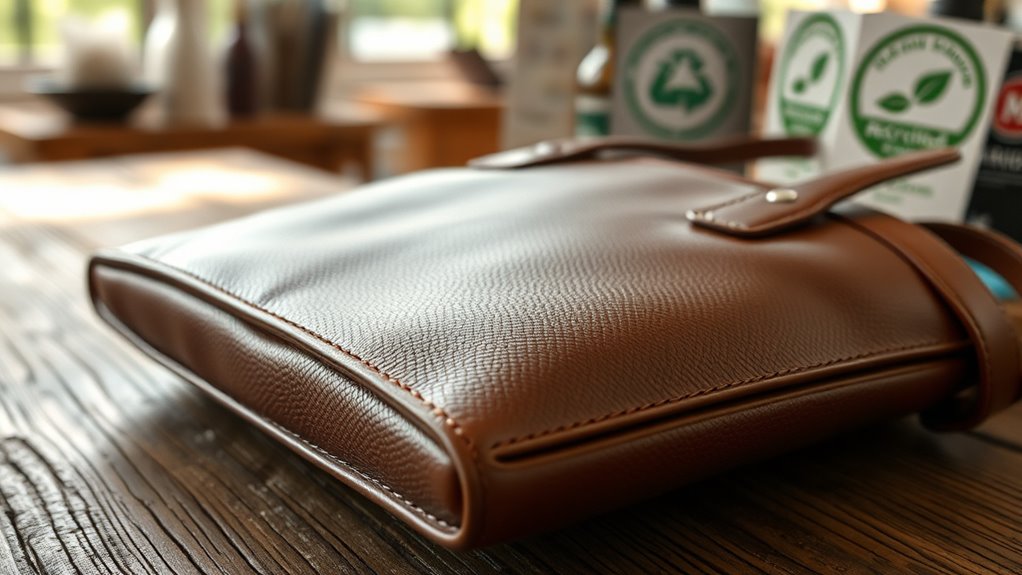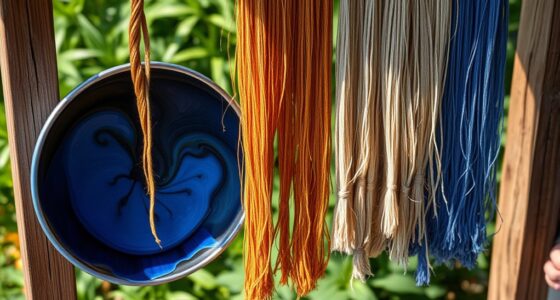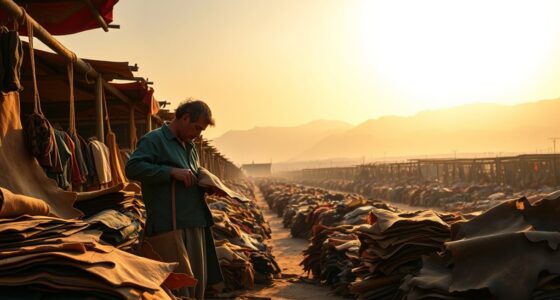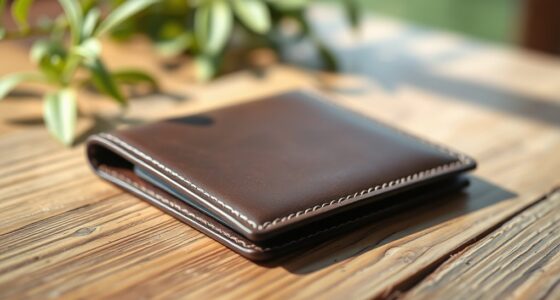Faux leather may seem eco-friendly, but its production involves harmful chemicals that pollute air, water, and soil. It’s often non-biodegradable and sheds microplastics that harm marine life and enter the food chain. Disposal remains a challenge, adding to landfill waste. However, brands are now innovating with biodegradable, plant-based, and recycled materials, making products greener. If you want to discover how companies are improving faux leather’s environmental impact, there’s more to uncover.
Key Takeaways
- Faux leather is non-biodegradable, contributing long-lasting waste and microplastic pollution from fiber shedding into ecosystems.
- Its production involves hazardous chemicals that release VOCs and pollutants, impacting air, water, and public health.
- Innovative brands are developing biodegradable, plant-based, and recycled materials to reduce environmental and chemical footprints.
- Consumer demand for cruelty-free, sustainable options encourages companies to adopt greener practices and increase transparency.
- Emerging technologies like mushroom leather and lab-grown plant proteins offer eco-friendly alternatives with lower lifecycle impacts.
The Environmental Footprint of Faux Leather Production

Although faux leather is often marketed as an eco-friendly alternative to genuine leather, its production still leaves a significant environmental footprint. One major issue is biodegradability concerns, as many faux leather materials do not break down easily, contributing to long-lasting waste in landfills. Additionally, the supply chain transparency of faux leather manufacturing varies widely, making it difficult to assess the true environmental impact. You might not see the full picture of how raw materials are sourced or processed, which can hide hidden environmental costs. This lack of transparency hampers efforts to improve sustainability. While faux leather avoids animal cruelty, its environmental benefits are compromised if production processes are not sustainable and materials are not biodegradable, highlighting the need for greater accountability in the supply chain. Moreover, the environmental footprint can be reduced through the use of sustainable materials and improved manufacturing practices.
Chemical Use and Pollutants in Faux Leather Manufacturing

Faux leather manufacturing involves the use of a variety of chemicals that can pose significant environmental and health risks. These include chemical toxins used in processing and finishing, which can contaminate air, water, and soil. During production, pollutant emissions release volatile organic compounds (VOCs) and other hazardous substances into the environment. These toxins can affect local communities and ecosystems, contributing to air pollution and water contamination. Many of these chemicals are difficult to break down and can accumulate in the food chain. As a result, manufacturing facilities often emit pollutants that threaten public health and biodiversity. Additionally, cybersecurity vulnerabilities in manufacturing systems can potentially be exploited to bypass safety measures, further exacerbating environmental hazards. Reducing chemical use and implementing cleaner production methods are vital steps to mitigate these environmental impacts and create more sustainable faux leather options.
The Lifecycle and Disposal Challenges of Faux Leather
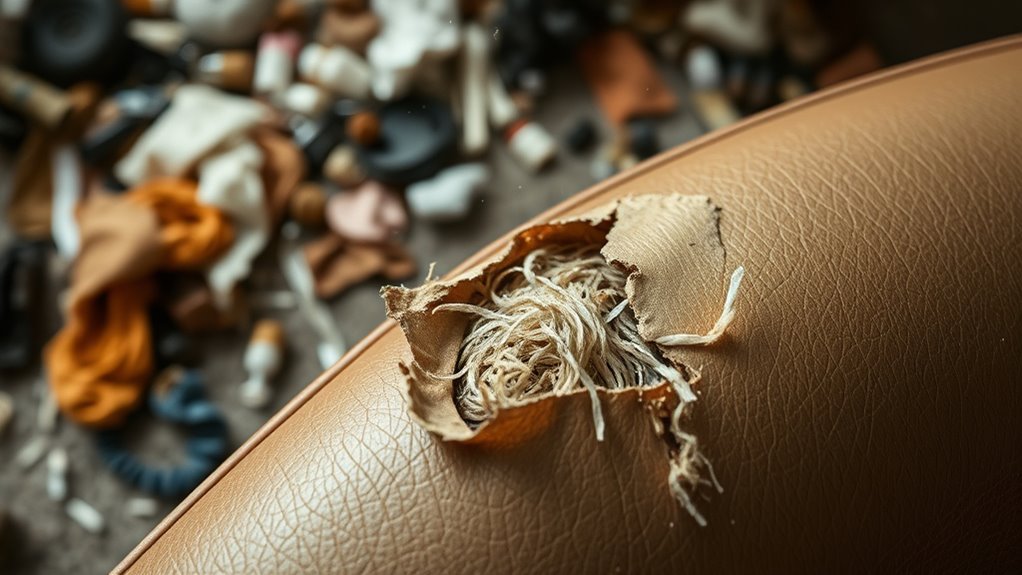
The lifecycle of faux leather presents significant disposal challenges because it is primarily made from synthetic materials like polyurethane and polyvinyl chloride (PVC), which do not decompose easily. This creates biodegradability challenges, as these materials can persist in landfills for decades without breaking down. Recycling obstacles also complicate disposal; faux leather is difficult to process because it combines plastics with adhesives and dyes, making it incompatible with standard recycling streams. As a result, most faux leather waste ends up in landfills or incinerators, contributing to environmental pollution. Additionally, the presence of relationship between materials complicates the development of effective recycling solutions. These disposal issues highlight the importance of developing more sustainable alternatives and improved recycling methods to reduce the environmental footprint of faux leather at the end of its lifecycle.
Microplastics and Their Impact on Marine Ecosystems
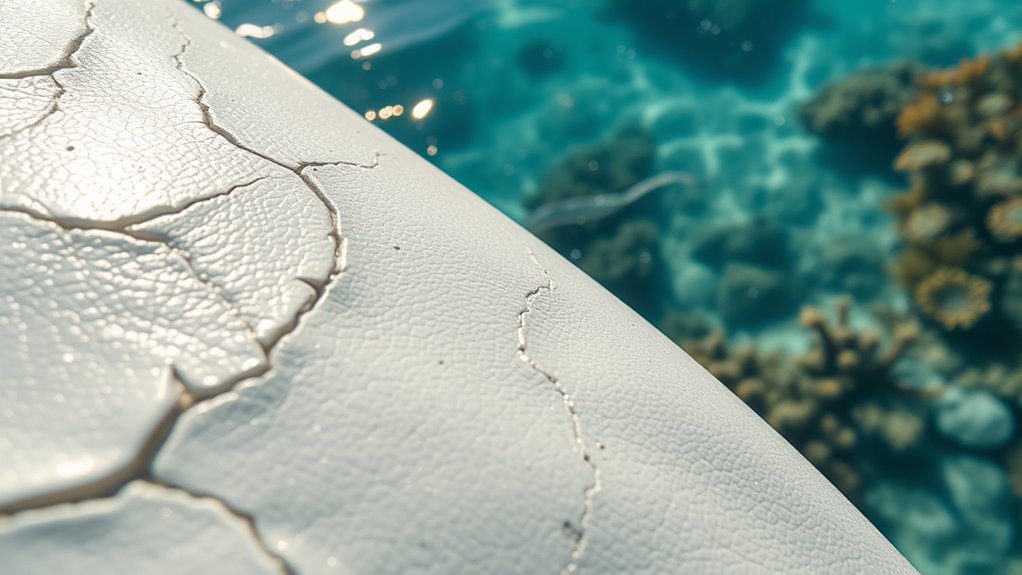
Microplastics have become a pervasive threat to marine ecosystems, as tiny particles from synthetic materials infiltrate oceans and waterways. These microplastics pollution sources include shed fibers from faux leather and other synthetic products, which break down over time. When you wear or discard faux leather, the shedding contributes to the growing microplastics presence in water systems. Marine life threats increase as fish, shellfish, and even plankton mistake microplastics for food, leading to ingestion and accumulation in the food chain. This contamination not only harms marine organisms but also affects human health through seafood consumption. Reducing microplastics pollution from faux leather and other synthetic materials is vital to protecting marine ecosystems and maintaining biodiversity. Your choices directly influence the health of our oceans.
Innovations in Sustainable Faux Leather Materials
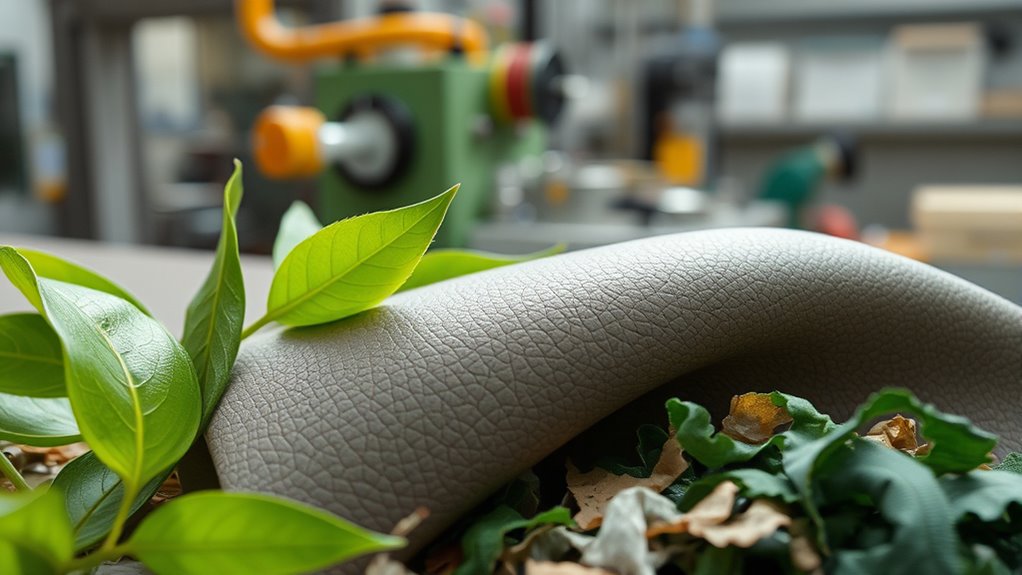
Innovations in sustainable faux leather materials are transforming the fashion industry by offering eco-friendly alternatives that reduce environmental impact. New developments focus on addressing biodegradability concerns, ensuring these materials break down naturally without leaving microplastic pollution. Brands are also pursuing vegan leather certifications, guaranteeing products are free from animal products and harmful chemicals. Imagine this: My dog’s names inspire creative and unique options for pet owners seeking to express their dog’s personality through name choices.
| Material Type | Key Features |
|---|---|
| Plant-Based Leather | Biodegradable, made from mushrooms or cactus, certified vegan |
| Recycled Plastic Leather | Uses post-consumer plastics, reducing waste, with eco-labels |
| Innovator Textiles | Combines bio-polymers that degrade over time, certified vegan |
| Bioengineered Leather | Lab-grown, biodegradable, with transparency on certifications |
These innovations help you choose products aligned with both environmental and ethical standards, tackling biodegradability concerns head-on.
Brands Leading the Way in Eco-Friendly Faux Leather
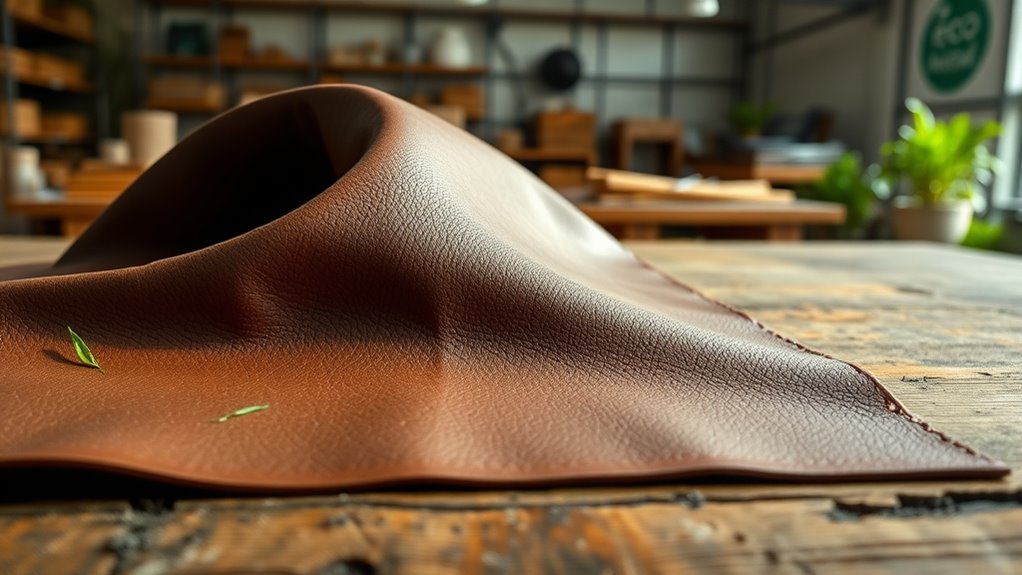
Many brands are setting new standards with innovative sustainable practices and eco-conscious material choices. You can now find companies that prioritize reducing environmental impact in every step of production. Their leadership inspires others to adopt greener approaches in the faux leather industry. Incorporating sound design techniques into product development and marketing can also effectively highlight these environmental efforts to consumers.
Innovative Sustainable Practices
Several brands are pioneering eco-friendly faux leather by adopting innovative sustainable practices that reduce environmental impact. They’re investing in biodegradable alternatives, which break down naturally without leaving harmful residues. These companies are also embracing regenerative farming techniques, restoring soil health and promoting biodiversity. By sourcing materials through regenerative practices, they reduce reliance on harmful chemicals and decrease carbon footprints. Additionally, some brands are implementing vertical farming methods to optimize space and resource efficiency home organization, ensuring raw materials are produced sustainably. These efforts not only lower the environmental costs associated with faux leather but also create a more resilient supply chain. This innovative approach demonstrates that eco-consciousness can be integrated into manufacturing without sacrificing quality, setting new standards for sustainable fashion.
Eco-Conscious Material Choices
Leading brands in the faux leather industry are now choosing eco-conscious materials that prioritize sustainability without compromising quality. They focus on animal welfare and uphold fashion ethics by selecting innovative alternatives. These materials include plant-based leathers, mushroom leather, and lab-grown options that don’t harm animals or the environment. Imagine a table showcasing these options:
| Material | Benefits | Impact on Animal Welfare |
|---|---|---|
| Plant-based | Biodegradable, renewable | Supports cruelty-free practices |
| Mushroom leather | Durable, compostable | No animals harmed |
| Lab-grown leather | Low environmental footprint | Ethical and sustainable |
In addition, many brands are actively reducing their carbon footprints by adopting these eco-friendly materials, demonstrating a commitment to environmentally responsible practices.
Consumer Choices and Their Role in Promoting Sustainability
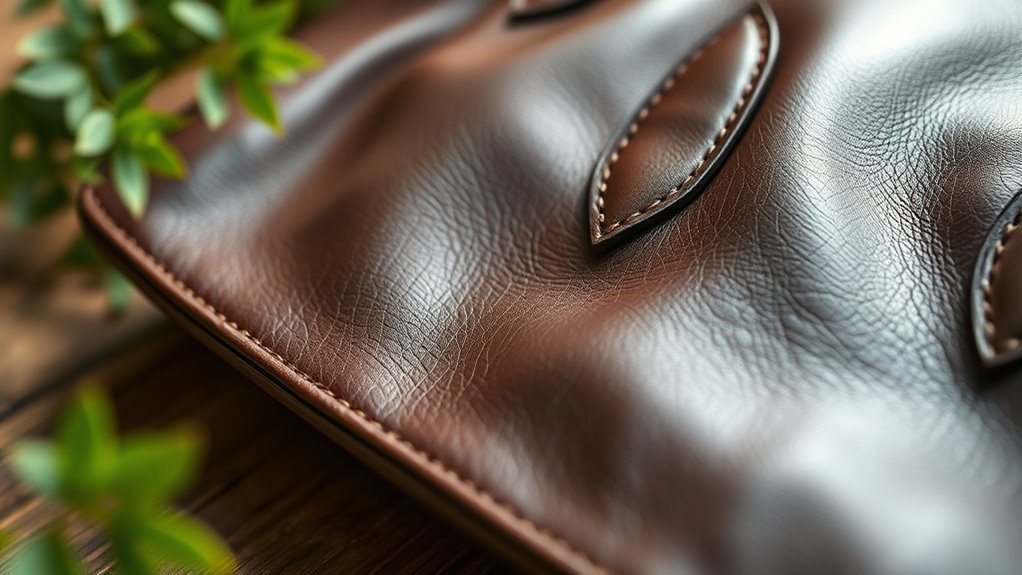
Have you ever considered how your purchasing choices can influence the environment? Your consumer awareness plays a essential role in promoting sustainability. By choosing products made from ethically sourced materials, you support brands committed to reducing environmental impact. To make impactful decisions, consider these steps:
- Research brands’ sustainability practices and transparency.
- Prioritize products with certifications indicating ethical sourcing.
- Support companies that invest in eco-friendly materials and transparent supply chains.
- Recognize how color accuracy in products can reflect a company’s commitment to quality and environmental responsibility.
Your choices encourage brands to adopt sustainable practices and innovate greener alternatives. When you demand eco-conscious options, you help shift the market toward more responsible production. Small, deliberate decisions can collectively drive significant change, making your role indispensable in fostering a more sustainable future.
Future Directions for Greener Faux Leather Alternatives
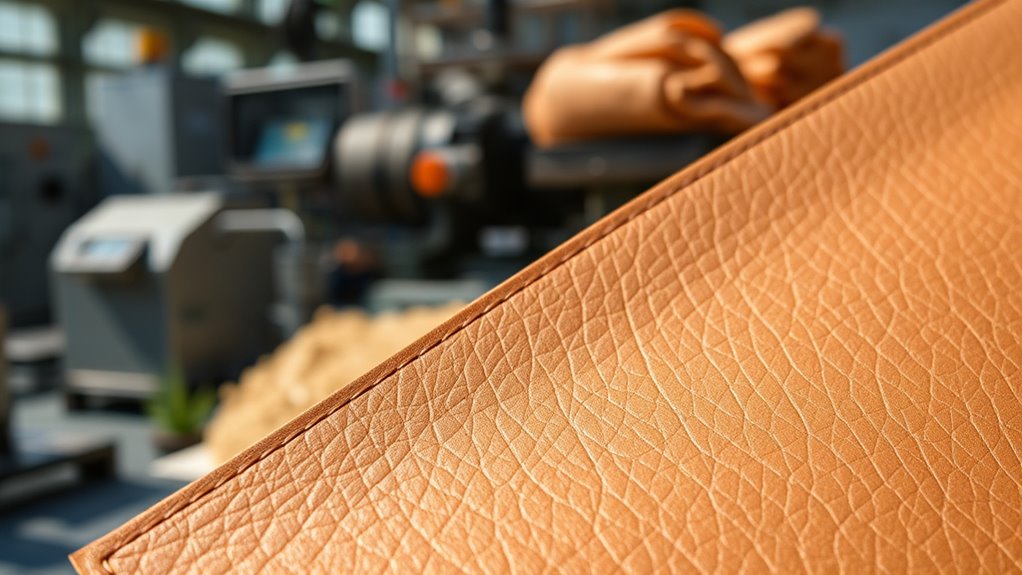
As research into sustainable materials advances, the future of greener faux leather alternatives looks promising. Innovators are exploring biodegradable alternatives and plant-based innovations to reduce environmental impact. These options aim to mimic leather’s qualities without harmful chemicals or long-lasting waste. Emerging materials like mushroom leather, pineapple fiber, and lab-grown plant proteins are gaining traction, offering eco-friendly solutions. Here’s a glimpse of potential future options:
| Material Type | Key Benefits |
|---|---|
| Mushroom Leather | Biodegradable, low energy production |
| Pineapple Fiber (Piñatex) | Uses agricultural waste, renewable resource |
| Lab-Grown Plant Proteins | Reduced land use, customizable properties |
| Algae-Based Materials | Fast-growing, carbon-sequestering |
| Recycled Plant Plastics | Circular use, less landfill waste |
These innovations promise a sustainable shift toward stylish, eco-conscious faux leather.
Frequently Asked Questions
How Does Faux Leather Production Compare to Genuine Leather in Carbon Emissions?
You might think faux leather has a smaller environmental footprint than genuine leather, but synthetic leather production actually generates more carbon emissions. It relies heavily on plastic, which involves energy-intensive processes and fossil fuels. While it avoids animal cruelty, its environmental impact includes higher greenhouse gases. So, when comparing the two, synthetic leather often has a larger carbon footprint, making genuine leather a potentially more eco-friendly choice depending on production methods.
Are There Biodegradable Faux Leather Options Available Today?
Like a phoenix rising from ashes, biodegradable faux leather options are emerging as eco-friendly materials you can choose today. These alternatives break down naturally, reducing environmental impact. Brands now offer innovative biodegradable options that mimic traditional faux leather’s look and feel while being kinder to the planet. By selecting these eco-friendly materials, you help lessen waste and support sustainable fashion, turning your choices into a symbol of hope for a greener future.
What Certifications Indicate Environmentally Responsible Faux Leather Products?
You should look for eco labels and certifications that show a product meets sustainable standards. Certifications like the Leather Working Group (LWG), Global Organic Textile Standard (GOTS), or OEKO-TEX Standard 100 help you identify faux leather options that are environmentally responsible. These eco labels guarantee the material’s production minimizes pollution, reduces chemical use, and upholds ethical practices, so you can make more sustainable choices when selecting faux leather products.
How Do Consumer Preferences Influence Brands’ Sustainability Efforts?
You can see that consumer demand heavily influences brands’ sustainability efforts. When you prioritize eco-friendly products, brands feel the pressure to improve their practices and demonstrate brand responsibility. Your choices and values push companies to develop better, more sustainable faux leather options, encouraging innovation and transparency. In this way, your preferences directly shape industry standards, making sustainability a key part of brand identity and product development.
What Policies Could Support Greener Faux Leather Innovation?
Imagine you’re in a sci-fi movie, but with real-world problems. You can support policies that promote sustainable funding for research and development of eco-friendly faux leather. Regulatory incentives, like tax breaks or stricter environmental standards, encourage brands to innovate greener alternatives. Your advocacy for these policies helps create a market where sustainable materials thrive, reducing environmental impact and pushing the industry toward more responsible and innovative practices.
Conclusion
By choosing eco-friendly faux leather options, you’re steering the ship toward a greener future, cutting through the pollution like a sharp knife. Every decision you make, from supporting sustainable brands to understanding the hidden environmental costs, helps turn the tide against environmental harm. Remember, your choices aren’t just drops in the ocean—they’re the waves that can reshape our planet’s future. So, stay informed, stay conscious, and let your style make a difference.
